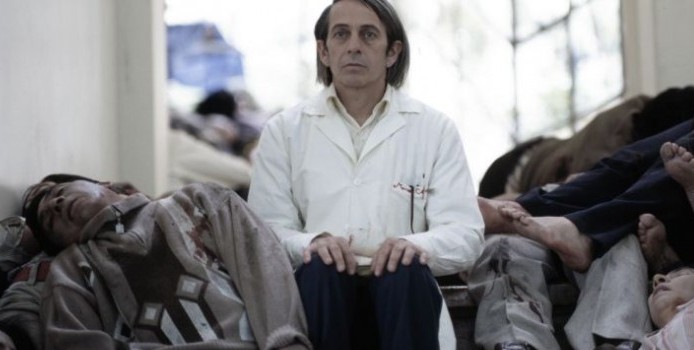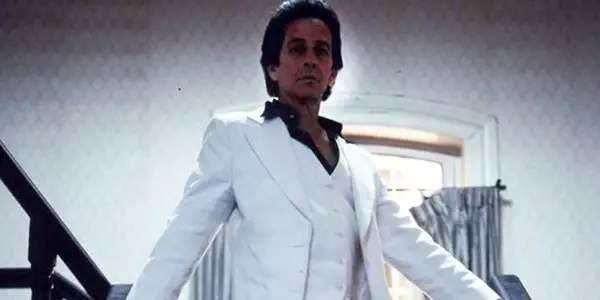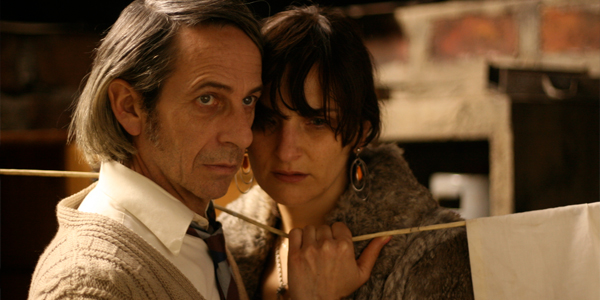Pablo Larraín’s Exploration of Chilean Politics: a Shocking View of Mayhem

Chilean. Living in Buenos Aires. Currently on book #4. Melomaniac,…
Chilean Filmmaker Pablo Larraín never mentioned the word Trilogy when he embarked on creating Tony Manero (2008), Post Mortem (2010) and No (2012), however, these three films do act as part of a whole: Larraín’s vision regarding Pinochet’s military coup of 1973 and the ensuing dictatorship.
Tony Manero and Post Mortem are both grim parables of folks stuck in a moral stupor, wandering the streets of a Chile that no longer knows itself, that silently witnesses the arrest and disappearance of hundreds of people every day, violence and torture a common thing and a convenient shroud for the crimes of civilians. In Larraín’s universe, the military are not the only ones getting away with murder: political turmoil also offers ordinary citizens, like Tony Manero’s Raúl Peralta and Post Mortem’s Mario Cornejo, opportunities in perversion.
The Pathos of Chile Under the Dictatorship
How easy it was to get caught up in the madness of Chile under the dictatorship. For a while, Society itself was the psychopath, the threat of death loomed everywhere: neighbors spying on neighbors, conversations taped to be used as evidence, words measured for appearances’ sake… For the common man, what did taking a life or two with impunity mean? Weren’t folks disappearing every day? Didn’t Pinochet, the head of government, send his minions to kill and violate in order to pursue his dream of a “free” state? If so, why couldn’t the common citizen get his way as well? Wasn’t the time ripe for this sort of thing?
Yes, Pablo Larraín explores all these themes using film as metaphor, his aim is nothing more than to show us the pathos of Chilean society during this dictatorship. Yet there is no character on which we can anchor our emotions, on the contrary, everything is explored with the utmost clinical detachment. It is this detachment that also acts as implicit criticism by Larraín regarding Chilean society’s inability to look back at events; our lack of acknowledgement concerning the violence past and present drives this trilogy- and I say “our” because I am Chilean. Larraín goes beyond the art of cinema for art’s sake, creating an exposé of despair, madness, dysfunctional sexuality and violence: ubiquitous horror that inspires every frame and lurks behind every sequence.
While Tony Manero and Post Mortem are the grimmer part of the trifecta, No is a film that offers a bit more hope: there is an important battle to be fought and there is an unconventional hero.
With that said, let’s take a look at Larraín’s trilogy, at how the pieces fit together to construct Larraín’s unique view of Chile under the Dictatorship.
Tony Manero : a Study in Violence
2008’s Tony Manero is not a subtle film. There is no redemption to be found, no kindness, not an ounce of mercy. It’s an emotionally ugly film, always titillating the audience’s sense of unease.
The film centers on Raúl Peralta (Alfred Castro), a drifter living in a “residencial” (a type of guest house) which is home to a variety of characters that dwell inside a spiritual vacuum. They are unlikeable, unpredictable, their half-finished sentences hang in mid-air, actions seem start with no resolution in sight. It is chilling, to sense the madness looming underneath the world Larraín has created. Even more chilling is the way they all cater to Peralta: in their minds, he is superior.

Yet Peralta is the biggest sociopath of them all. We see his vacant stare via close-ups, the camera always on him, on his dirty beard stubble, the grime on his shirt collar, the void in his eyes. It is brilliant claustrophobic camera work by cinematographer Sergio Armstrong, who would go on to work with Larraín in Post Mortem and No. Armstrong also gave the film dry, lifeless colors, everything is a composite of dull browns, beiges and yellows.
The film conveniently starts out with Peralta signing up for a Tony Manero impersonator contest. Before we are introduced to the full extent of his sociopathy – in an unexpected, shocking sequence, we almost feel sorry for him, for his lack of vocabulary, for this tiny dream he holds, that of impersonating Manero. We see him at a dingy movie theatre, reciting lines from Saturday Night Fever by heart, in soft, broken English. He is a man with an obsession, but he is also a black hole – leaving nothing but violence and murder in his wake, in his efforts to achieve his “dream”.
The film doesn’t spare Peralta – one of actor Alfredo Castro’s finest performances. He is shown in all his miserable glory: sexually impotent, amoral, empty. Vacant eyes, other times even murderous. It is simply amazing what Castro can do with his face.
Moreover, there is not an ounce of sympathy to his character. He is all black. If there is any fault with the film, it would be this, a character so extreme, you have nothing to latch onto in terms of humanity. But of course, Larraín’s trilogy has this in common: no emotional anchors. Just sight, the ability to stand back and witness the horror.
If Pablo Larraín wanted to create an analogy between Peralta and the cold, dark, heart of the military regime, then he did it brilliantly. Peralta is at once the common citizen, but he is also the executioner.
The emotional and spiritual violence of this film will leap at you from the screen. You will want to look away, but you won’t, because something about the world Larraín has created and its wretched protagonist will fascinate you. You will keep on looking, if only to acknowledge that the film is an artistic depiction of a time where madness ran like a river and the common citizens held on to anything they could for sanity: a television set, a seedy bar, empty sex, obsession.
Post Mortem : The Military Coup’s Grim Witness
In a similar vein to Manero, Post Mortem (2010) is a slow descent into the pathos of Chile’s recent history, but this time, the setting is during the Coup itself – on and around September 11th, 1973.
The camerawork we got used to in Manero is also present here: fixed frames and ominous dead space; claustrophobic close-ups and lifeless, washed-out colors via the skilled hand of Sergio Armstrong. Armstrong manages to infuse the film with a sense of dread turned into aesthetics. He is a master creator of atmosphere and one can understand why Pablo Larraín would choose him for his film projects. Armstrong is the thread that visually binds Larraín’s three films together. However, a word of caution to those that like their camera a bit more dynamic, the stillness of the camerawork might be off-putting to some.

Post Mortem tells the story of Mario Cornejo – again played by Alfredo Castro, a quiet morgue employee obsessed with his neighbor, a vaudeville dancer. Mario is not a sociopath of the caliber of Manero’s Raúl Peralta, yet his pathos is equally disturbing because it is slow. It creeps up on Cornejo and the viewer can sense his descent into the pit. Both Manero and Post Mortem are nothing if not brilliantly shot funeral marches. Also, and in a similar vein to Manero, Mario is given the same perverse opportunity, a chance to get away with violence, but in this film, it is far more subtlety handled. With Mario Cornejo, everything is toned down.
There are moments of sheer abjection: Mario and his neighbor Nancy, crying over dinner, two souls realizing, if only for a moment, the banality of it all. Careers that go nowhere, unfulfilling emotional lives set amidst the political chaos of a country for the taking… Or the corpses that pile up in the morgue: in hallways, two for every stretcher; even deposed President Allende’s body is autopsied, in plain sight of the ones responsible for the coup. A sacrilege and one that the audience feels deeply: the historical charge of President Allende’s death cannot be understated when talking about Chilean history.
Post Mortem is the the Coup’s grim witness, its eyes set on the first few days of terror, the solitary streets, the fear, the ominous green military uniforms everywhere. It is the door to Manero, and like it, it becomes a dive into the darkest recesses of the human spirit, unleashed and shrouded by this coup that leaves no one indifferent.
No : Joy Found, Joy Lost
No (2012) is Larraín’s final installment in his Political Trilogy. It takes place during the last year of the dictatorship, a witness to its demise at the crafty hands of pop culture advertising.
In 1988, Pinochet calls for a referendum, giving Chileans the liberty to decide whether they would keep him as head of Government for eight more years (the SI option of the referendum) or whether free elections would be held (the NO option) – thus generating a new chapter in Chile’s history: democracy. Each option had a couple of minutes – 15 to be exact, in which to advertise their option on national television. Larraín’s third film chronicles the advertising campaign behind the NO option, using actual footage of the time and the actual faces of the campaign: celebrities and politicians making brief cameos alongside the taped version of their younger selves. If nothing, else, No is a brilliant exercise in seamless editing.

For those of us who were children in Chile in 1988, the movie is a walk down memory lane. How familiar the rainbow seems, a logo conveniently devised for the NO option, a herald of the “joy to come” as the campaign motto states. Chile, La Alegría Ya Viene —Chile, Joy is Coming— is the motto sung over and over, a prayer if there ever was one.
But as all Larraín films, while the surface may appear to be a celebration – wonderfully shot with an old-school Ikegami camera on ¾” video, giving the film its grainy, 80’s feel, there are neurosis at play here: strife among the NO campaign participants, a generational gap, empty lives and ultimately, the question of purpose.
Gael García Bernal stars as René Saavedra, the son of exiled Chilean parents, who returns to Chile as an adult, landing a job in the advertising industry. He is certainly the hero of the film, albeit an unsympathetic one. Saavedra’s intentions are never made clear and just like Raúl Peralta and Mario Cornejo, there is a certain deadness to his stare: he is a man without a center.
Saavedra is convinced by an old friend to lead the NO campaign, with all the turmoil it entails. He finds himself stuck between the general consensus that the referendum has been rigged and the NO option will not win, yet for the first time in history the left wing has “almost” free reign to say what it will on TV, and they want to use it to spill out 15 years of imposed silence. Saavedra must do right by the NO option: bring it to the forefront of the advertising race and in so doing, fight a dire battle. It’s hard to convince the older generation that a little pop culture magic – known as modern advertising techniques and persuasion – can go a long way.
Pedro Pereira’s screenplay is adept at taking fact and turning it into fiction. The way the NO campaign was conducted is not accurate. René Saavedra never existed (though he is a composite of several people involved in the campaign). However, the final product is a film firmly grounded in the big issues of the time: the battle between the SI and the NO, the strife, the petty quarreling among the members, the veiled threats to the integrity of the NO’s project by the unseen mechanisms of repression.
The montage is beautiful, it takes a visual genius like Andrea Chignoli to seamlessly integrate old footage and new, creating sequences that feel whole; and of course, Sergio Armstrong’s cinematography is as solid as ever, ensuring the old and new blend together, using the same outdated film technology to give the illusion of truth.
While No might be considered the more hopeful film of the trilogy, it still manages to critique the “joy to come”. It has been 25 years since the fall of the dictatorship and Chile is still plagued by similar political and social issues; there is, in René, the very palpable struggle between consumerism and principle. His life seems empty, devoid of meaning and the persuasion he so deftly wields through advertising is hollow, meant to influence for the greater good, yes, but useless in terms of spirit. There is no growth in René’s journey, no lessons learned. He has served a utilitarian purpose and he realizes it.
The only person that to him, seems grounded in reality and conviction is his ex-wife, a passionate activist at the forefront of change. It is her approval René seeks to win.
In the end, joy does come to Chile, if only for a short while. Time is inexorable and human beings always find a way of ruining a good thing. The lonely are left to ponder their solitude, the greedy will find other ways of stealing, the passionate will continue to be driven by their hearts. And then there are those like René Saavedra, who, riding a skateboard at the end of the film, finds himself just as alone as when his big project all started. None the wiser, none the happier. Same spirit, different government. A lonely street, a skateboard.
Larraín, Guardian of Our Collective Memory
Finally, Manero, Post Mortem and No, can be viewed as tokens for a society that wishes to forget, that fails to look back on its recent past, but that is made to remember by the skilled hand of Pablo Larraín. It is an exercise in thoughtfulness, no matter how twisted the source material. Both Chilean and foreign audiences will, if only for a couple of hours, witness a time outside their usual perception; immersing themselves in the darker realms of human consciousness and activity: a grim reminder of the breakage unrestrained violence leaves in its wake.
For the film lover out there, this Trilogy is a must-watch.
How about you? Do you know anything about the Chilean Coup of September 11th, 1973? Are you familiar with Larraín’s work? We’d love to hear your thoughts.
(top image source: Post Mortem – Fábula/Canana Films/Autentika)
Does content like this matter to you?
Become a Member and support film journalism. Unlock access to all of Film Inquiry`s great articles. Join a community of like-minded readers who are passionate about cinema - get access to our private members Network, give back to independent filmmakers, and more.
Chilean. Living in Buenos Aires. Currently on book #4. Melomaniac, cinephile, books, & tea. Premature gray hair. Likes succinct by-lines as you can see, but in real-life, she can talk her way into and out of most anything.













